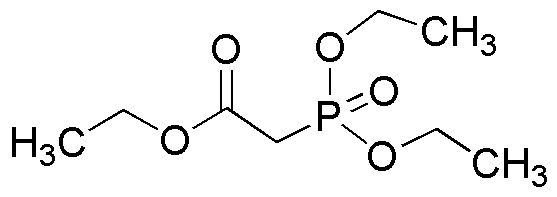Triethyl phosphonoacetate is widely utilized in research focused on:
- Pharmaceutical Development: This compound serves as a key intermediate in the synthesis of various pharmaceuticals, particularly in the development of antiviral and anticancer agents.
- Agricultural Chemicals: It is used in the formulation of pesticides and herbicides, enhancing the efficacy of active ingredients while reducing environmental impact.
- Organic Synthesis: Researchers leverage its unique reactivity in organic synthesis, particularly in the preparation of phosphonate derivatives, which are valuable in various chemical applications.
- Biochemical Research: Triethyl phosphonoacetate is employed in studies involving enzyme inhibition and metabolic pathways, aiding in the understanding of biochemical processes.
- Material Science: This compound is explored for its potential in developing new materials, including polymers and coatings, due to its phosphonate group that can enhance material properties.
General Information
Properties
Safety and Regulations
Applications
Triethyl phosphonoacetate is widely utilized in research focused on:
- Pharmaceutical Development: This compound serves as a key intermediate in the synthesis of various pharmaceuticals, particularly in the development of antiviral and anticancer agents.
- Agricultural Chemicals: It is used in the formulation of pesticides and herbicides, enhancing the efficacy of active ingredients while reducing environmental impact.
- Organic Synthesis: Researchers leverage its unique reactivity in organic synthesis, particularly in the preparation of phosphonate derivatives, which are valuable in various chemical applications.
- Biochemical Research: Triethyl phosphonoacetate is employed in studies involving enzyme inhibition and metabolic pathways, aiding in the understanding of biochemical processes.
- Material Science: This compound is explored for its potential in developing new materials, including polymers and coatings, due to its phosphonate group that can enhance material properties.
Documents
Safety Data Sheets (SDS)
The SDS provides comprehensive safety information on handling, storage, and disposal of the product.
Product Specification (PS)
The PS provides a comprehensive breakdown of the product’s properties, including chemical composition, physical state, purity, and storage requirements. It also details acceptable quality ranges and the product's intended applications.
Certificates of Analysis (COA)
Search for Certificates of Analysis (COA) by entering the products Lot Number. Lot and Batch Numbers can be found on a product’s label following the words ‘Lot’ or ‘Batch’.
Numéro de catalogue
Numéro de lot/série
Certificates Of Origin (COO)
This COO confirms the country where the product was manufactured, and also details the materials and components used in it and whether it is derived from natural, synthetic, or other specific sources. This certificate may be required for customs, trade, and regulatory compliance.
Numéro de catalogue
Numéro de lot/série
Safety Data Sheets (SDS)
The SDS provides comprehensive safety information on handling, storage, and disposal of the product.
DownloadProduct Specification (PS)
The PS provides a comprehensive breakdown of the product’s properties, including chemical composition, physical state, purity, and storage requirements. It also details acceptable quality ranges and the product's intended applications.
DownloadCertificates of Analysis (COA)
Search for Certificates of Analysis (COA) by entering the products Lot Number. Lot and Batch Numbers can be found on a product’s label following the words ‘Lot’ or ‘Batch’.
Numéro de catalogue
Numéro de lot/série
Certificates Of Origin (COO)
This COO confirms the country where the product was manufactured, and also details the materials and components used in it and whether it is derived from natural, synthetic, or other specific sources. This certificate may be required for customs, trade, and regulatory compliance.

